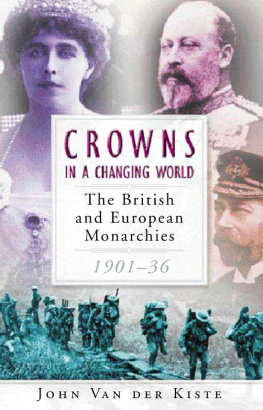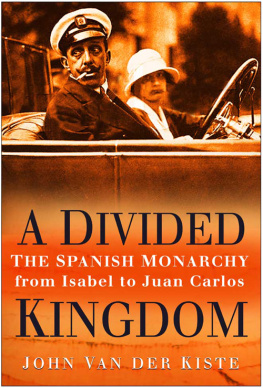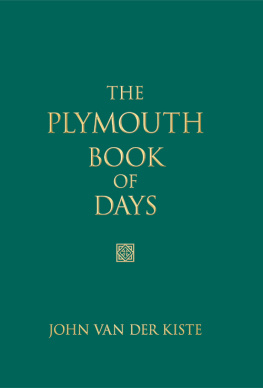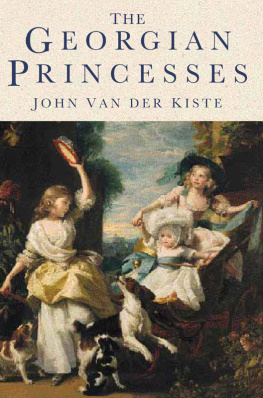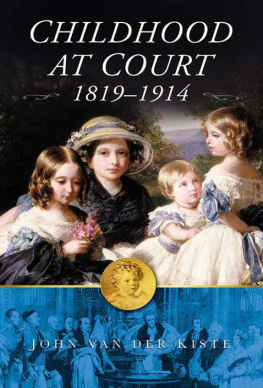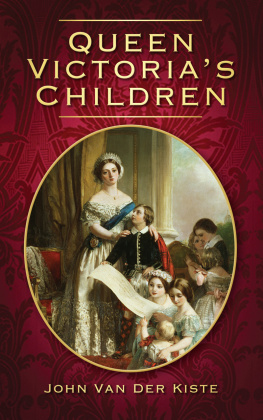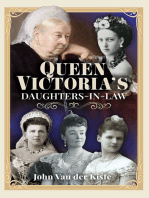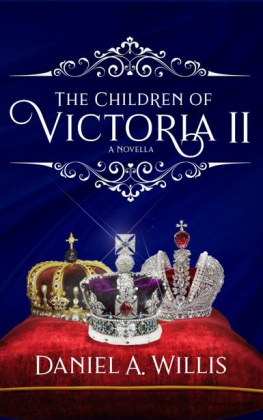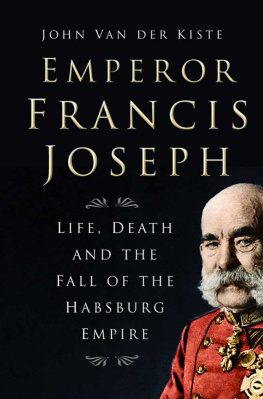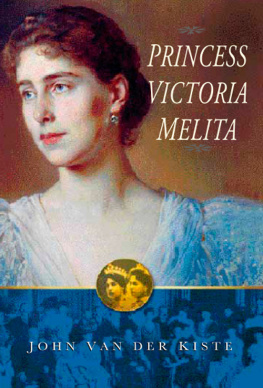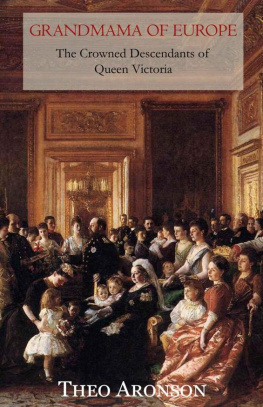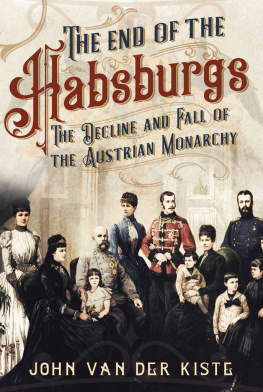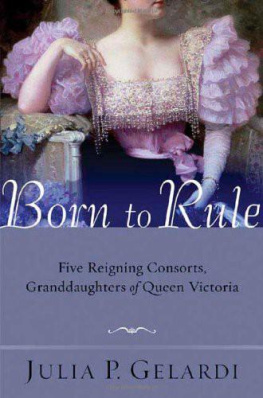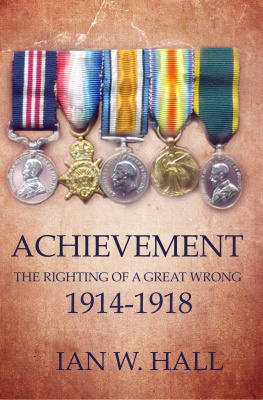C ROWNS
IN A CHANGING WORLD
ALSO BY JOHN VAN DER KISTE
Published by Sutton Publishing unless stated otherwise
Frederick III: German Emperor 1888 (1981)
Queen Victorias Family: A Select Bibliography (Clover, 1982)
Dearest Affie: Alfred, Duke of Edinburgh, Queen Victorias Second Son, 18441900 [with Bee Jordaan] (1984)
Queen Victorias Children 1986; large print edition, ISIS, 1987)
Windsor and Habsburg: The British and Austrian Reigning Houses 18481922 (1987)
Edward VIIs Children (1989)
Princess Victoria Melita, Grand Duchess Cyril of Russia, 18761936 (1991)
George Vs Children (1991)
George IIIs Children (1992)
King of the Hellenes: The Greek Kings 18631974 (1994)
Childhood at Court 18191914 (1995)
Northern Crowns: The Kings of Modern Scandinavia (1996)
King George II and Queen Caroline (1997)
The Romanovs 18181959: Alexander II of Russia and his Family (1998)
Kaiser Wilhelm II: Germanys Last Emperor (1999)
The Georgian Princesses (2000)
Gilbert & Sullivans Christmas (2000)
Dearest Vicky, Darling Fritz: Queen Victorias Eldest Daughter and the German Emperor (2001)
Royal Visits in Devon and Cornwall (Halsgrove, 2002)
Once a Grand Duchess: Xenia, Sister of Nicholas II [with Coryne Hall] (2002)
William and Mary (2003)
C ROWNS
IN A CHANGING WORLD
The British and
European Monarchies
190136
JOHN VAN DER KISTE

First published in 1993
This revised paperback edition first published in 2003
The History Press
The Mill, Brimscombe Port
Stroud, Gloucestershire, GL5 2QG
www.thehistorypress.co.uk
This ebook edition first published in 2013
All rights reserved
John Van der Kiste, 1993, 2003, 2013
The right of John Van der Kiste to be identified as the Author of this work has been asserted in accordance with the Copyrights, Designs and Patents Act 1988.
This ebook is copyright material and must not be copied, reproduced, transferred, distributed, leased, licensed or publicly performed or used in any way except as specifically permitted in writing by the publishers, as allowed under the terms and conditions under which it was purchased or as strictly permitted by applicable copyright law. Any unauthorised distribution or use of this text may be a direct infringement of the authors and publishers rights, and those responsible may be liable in law accordingly.
EPUB ISBN 978 0 7524 9927 7
Original typesetting by The History Press
CONTENTS
FOREWORD
T he thirty-five years during which King Edward VII and King George V reigned over Great Britain saw a considerable change in the European monarchies. The British Crown and its standing with its subjects altered but little, while many of the thrones which seemed powerful or safe enough in the Europe of 1901 had gone by 1936. This book is an attempt to trace the personal relations between both Kings, and their royal and imperial contemporaries on the continent during that period which saw the last flowering of lancien rgime, the Great War, and the rise of the dictators.
In accordance with usage generally employed by newspapers of the time, monarchs are referred to by their titles throughout, even after abdication. For example, the German Emperor William II is still the Emperor and not the ex-Emperor during his years of exile.
I wish to acknowledge the gracious permission of Her Majesty The Queen to publish material from the Royal Archives, Windsor. I am indebted to the following copyright holders for permission to quote from published sources: Collins Harvill (Uncle of Europe, by Gordon Brook-Shepherd); and Constable & Co. Ltd (King George V, by Harold Nicolson).
As ever, I am particularly grateful to my parents, Wing Commander Guy and Nancy Van der Kiste, for their constant encouragement, help, and advice throughout. I am also indebted to Charlotte Zeepvat, Theo Aronson, Steven Jackson of the Commemorative Collectors Society, and John Wimbles, for their assistance and for providing invaluable sources of information which I would otherwise have missed; and to the staff of Kensington and Chelsea Public Libraries, for allowing me access to their excellent biography collection. Last but not least, my thanks to Stella Clifford, whose ideas were largely responsible for this book in the first place; and to Rosemary Aspinwall, for her work in helping to see this volume through to publication.
John Van der Kiste
PROLOGUE
T hroughout much of her reign Queen Victoria, the Grandmother of Europe, had connections through family ties with almost every other royal court in Europe. When she ascended the throne in 1837, her Uncle Leopold had been King of the Belgians for nearly six years. Her eldest daughter Victoria, Princess Royal, was married in 1858 to Prince Frederick William of Prussia, destined to reign all too briefly as German Emperor. Her eldest son Albert Edward, Prince of Wales, who succeeded her as King Edward VII, married Princess Alexandra of Denmark in 1863, thus becoming the son-in-law of the Prince destined to become King Christian IX before the end of the year. Her second son Alfred, Duke of Edinburgh, married Grand Duchess Marie, daughter of Alexander II, Tsar of Russia, in 1874. Three other daughters and one younger son also married German royalty, although less prestigiously; while in her latter years, two granddaughters married the heirs to the thrones of Greece and Roumania, and another the Tsar of Russia.
Inevitably, the consequent divisions in national loyalties involved them in heated arguments during several of the numerous albeit brief wars that took place in Europe during the second half of the nineteenth century. The Queen was entirely German by blood, with Hanoverian, Brunswick, Saxe-Coburg and Mecklenburg-Strelitz ancestry. Marriage to a first cousin from the house of Saxe-Coburg Gotha had merely reinforced the German element, and her sympathies always remained overwhelmingly German. If that nations interests clashed with those of other countries, there was never any doubt which cause must always be upheld.
Early proof was given of this in 1864 when the Princess of Wales father King Christian IX was embroiled in war with Bismarcks Prussia over the duchies of Schleswig and Holstein. The bellicose Otto von Bismarck, appointed Minister-President of Prussia in 1862, was determined to raise the standing of Prussia in Germany through a ruthless policy of blood and iron, and Denmark was his first victim.
The protests of Princess Alexandra, and her husband, that the duchies belonged to her father, carried no weight with the Queen. British public opinion sided firmly with the Prince and Princess, but while the government remained neutral during the short military campaign, Queen Victoria made no secret of her personal support for Germany and her eldest daughter and son-in-law. Family arguments at Windsor became so impassioned at one stage that the harassed matriarch firmly forbade any mention of Schleswig and Holstein in her presence.
Bismarck tested the Queens Teutonic partisanship to its limits two years later when he turned on Austria, Prussias ally in the Danish war, in order to drive her out of the North German confederation and establish Prussian supremacy in Germany. Among the German states taking Austrias side on the battlefield was the Grand Duchy of Hesse, whose heir presumptive, Louis, was married to Queen Victorias second daughter Alice. Though the Queen was so angered by Bismarcks behaviour that she was tempted to express her support for Austria, Hesse and their allies, or at least help mediate between both factions, the swift, crushing Prussian triumph put paid to such hopes and ideas. Unpalatable as it was, Prussian hegemony had to be accepted.
Next page
